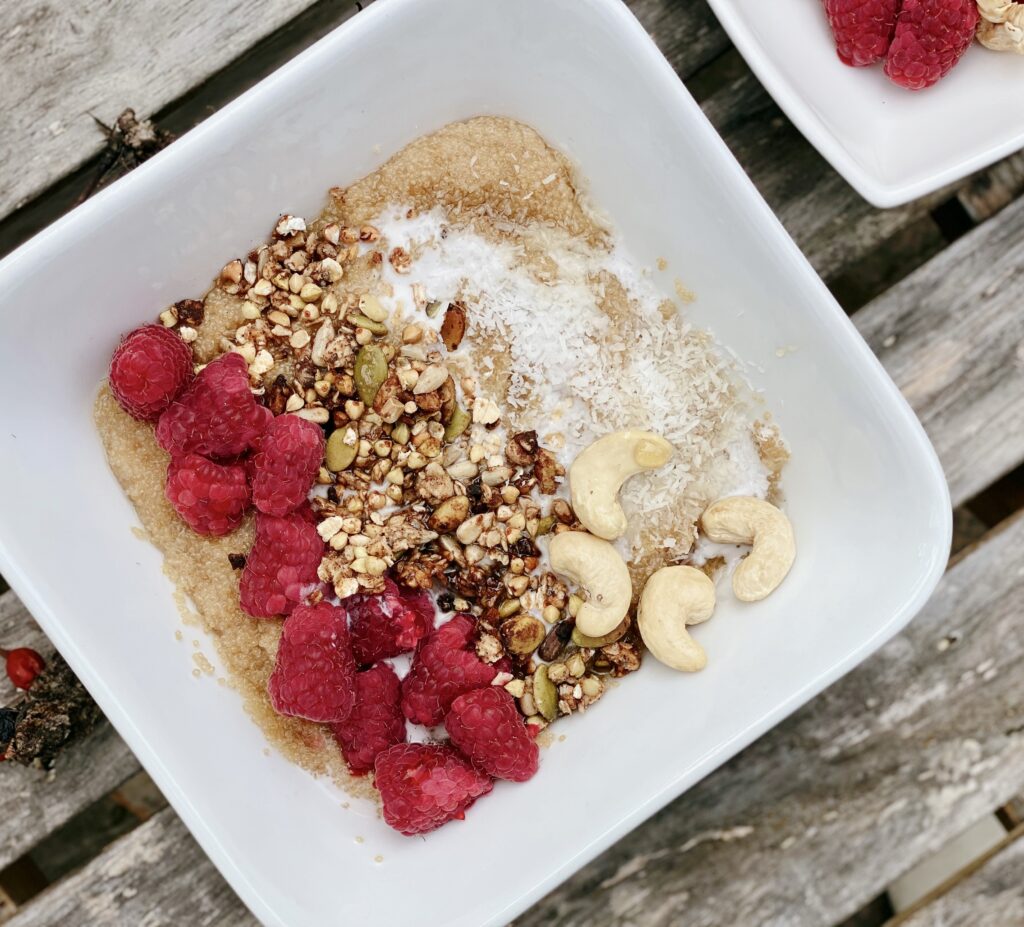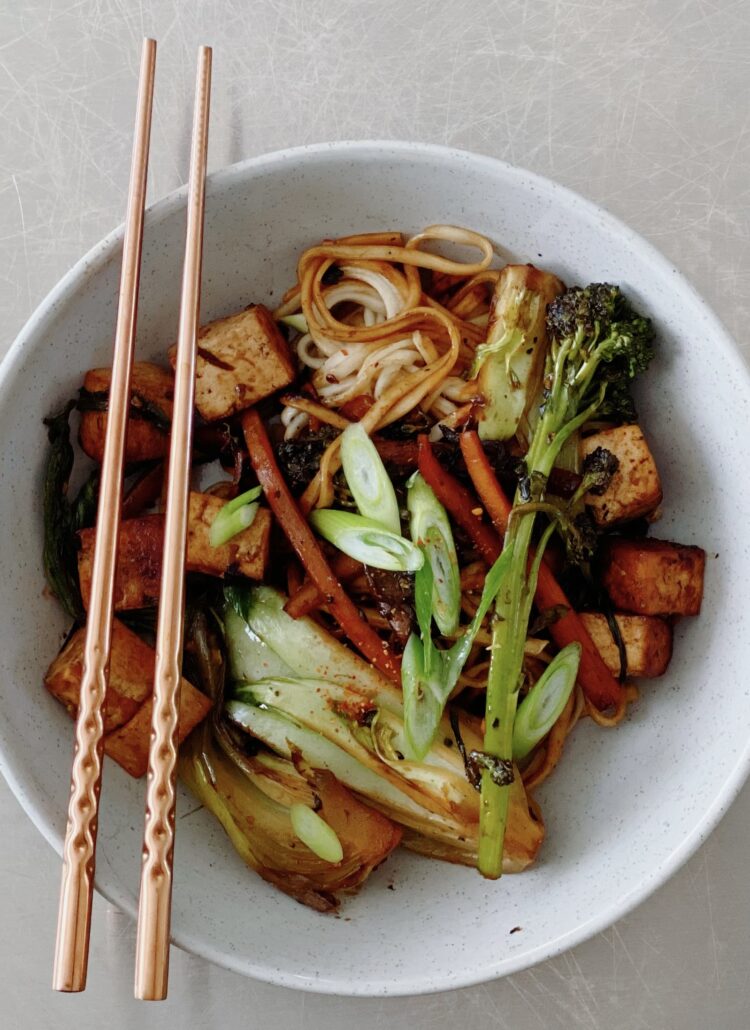Swap your ordinary oats for our Creamy Amaranth Porridge with Raspberries, and start the day with a nutritious, delicious twist!

Hey there, awesome reader! Today, I want to tell you about a super-duper grain that’s been around for a LONG time. It’s called Amaranth, and it’s pretty much like a protein superhero in the world of grains.
Ready to dive in? Let’s go!
Starting your day with low GI grains like amaranth can help stabilize blood sugar levels, providing sustained energy. Pairing it with raspberries—rich in natural sugars and fiber—supports a slow energy release, helping to avoid afternoon energy dips.
funkin healthy
Why Choose Amaranth Porridge Over Other Breakfast Options?
Here’s why this porridge should become a staple in your morning routine:
- Complete Protein Profile: A rare gem in the plant world, ideal for vegans and vegetarians.
- Mineral-Rich: Dive into a plethora of magnesium, iron, phosphorus, and manganese.
- Dietary Fiber: A gut-friendly choice that aids in digestion and cholesterol management.
- Antioxidant Properties: Helps fight off free radicals.
- Vitamin E and Calcium: Boosts skin health, immune function, and bone strength.
- Low Glycemic Index: Amaranth can help stabilize blood sugar levels, making it beneficial for diabetics.
Amaranth: Once a staple in the diet of ancient Aztecs, amaranth is a grain that’s not only gluten-free but also rich in fiber, protein, magnesium, and iron.
Its protein content is uniquely complete, as it contains lysine, an amino acid missing or negligible in many grains.
Raspberries: Packed with dietary fiber, vitamins C and K, and antioxidants, raspberries can support heart health, aid digestion, and even offer anti-inflammatory properties.
funkin healthy
Amaranth: The High Protein Superfood Grain
Amaranth isn’t just another grain; it’s a high-protein superfood that stands out in the world of plant-based nutrition. Amaranth is economically viable and climate-friendly, promising to become a staple grain of this century.
How Does Amaranth Compare To Other Grains?
Amaranth holds unique characteristics that distinguish it from traditional grains like wheat, rice, and oats.
1. Nutritional Profile:
- Protein Content: It’s one of the few plant sources containing all essential amino acids, making it a complete protein. This sets it apart from most other grains.
- Rich in Minerals: Amaranth has higher levels of calcium, iron, magnesium, and manganese compared to many traditional grains.
- Gluten-Free: Unlike wheat and barley, amaranth is naturally gluten-free, making it suitable for those with gluten sensitivities.
2. Taste and Cooking:
Amaranth has a unique flavor and texture:
- Taste: It has a mildly nutty and earthy flavor, different from the neutral taste of rice or the chewy texture of oats.
- Texture: When cooked, amaranth turns into a thick, creamy consistency, unlike the fluffy texture of cooked quinoa or rice.
- Versatility: Amaranth can be popped, cooked into porridge, or used as a thickening agent in soups and stews.
Nutritional Comparison Chart:
| Nutrient (per 100g) | Amaranth | Quinoa | Oats | Brown Rice |
|---|---|---|---|---|
| Calories | 371 | 368 | 389 | 362 |
| Protein (g) | 14.45 | 14.12 | 16.89 | 7.94 |
| Total Fat (g) | 6.51 | 6.07 | 6.90 | 2.92 |
| Carbohydrates (g) | 65.25 | 64.16 | 66.27 | 76.17 |
| Fiber (g) | 6.7 | 7.0 | 10.6 | 3.4 |
| Magnesium (mg) | 248 | 197 | 177 | 143 |
| Iron (mg) | 7.61 | 4.57 | 4.72 | 1.47 |
| Calcium (mg) | 159 | 47 | 54 | 23 |
Can Amaranth Help with Weight Loss? While not a miracle solution, amaranth’s high fiber and protein content can support weight loss when paired with a balanced diet and active lifestyle.
funkin healthy
Amaranth Around the World
Amaranth is a grain with a rich history and cultural significance, particularly in the indigenous civilizations of Mesoamerica such as the ancient Aztecs, Hopi, and Mayan people.
Ancient Aztecs and the “Golden Grain: In ancient Mesoamerican societies, amaranth was highly esteemed. It played a significant role beyond just being a staple food, being used in religious ceremonies and to create statues of deities. The Aztecs called it ‘huauhtli’ and considered it a source of strength.
India’s Rajgira: In many parts of India, amaranth is known as ‘rajgira. It’s used in flatbreads, sweets, and as a fasting food due to its unique non-cereal status. The ‘rajgira puri,’ a deep-fried flatbread, is especially popular during fasting periods.
African Innovations: In some parts of Africa, amaranth leaves, known as ‘terere’ or ‘dodo,’ are widely consumed. They are often sautéed with spices, creating a nutritious and tasty side dish.

Red Raspberries: Key Health Insights
The antioxidant properties of raspberries are remarkable, and here’s why they should be a part of your diet:
Nutritional Highlights: Raspberries are antioxidant-rich, especially in Vitamin C, quercetin, and gallic acid. They contain ellagic acid, known for cancer prevention, and have a high antioxidant capacity. Whole berries are more beneficial than individual supplements.
Cancer Prevention with Ellagic Acid: Red raspberries have historically been used for various remedies. They may prevent cancer by regulating cell behavior. The body absorbs ellagic acid from raspberries, which can induce cell death in some cancer cells. This acid has potential anti-cancer effects against several types of cancers.
Phytochemicals: Raspberries contain quercetin, effective against certain cancers, and anthocyanins, antioxidants that guard against heart disease and cognitive decline.
Ready to Try?
Ready to elevate your breakfast? Discover our amaranth porridge recipe today!
Do you have another exciting amaranth recipe up your sleeve?
Send me a mouthwatering photo of your amaranth porridge along with the recipe!
Use #funkinhealthy on IG to tag your creation.
🔗 Looking for more protein-rich breakfast options? Try these:
🍓 High Protein Berry Oat Bars: Whip up these omemade oat bars with added protein powder, nuts and berries for a tasty and nutritious breakfast or snack.
🥑 Protein Packed Avo Toast: Not your ordinary avo on toast! Slice some avocados and spread with miso tofu paste for a protein-rich breakfast.
🍇 Goji Berries Oatmeal Bowl: Enjoy a nourishing oatmeal bowl loaded with goji berries and coconut. Bonus: add charcoal powder to improve digestion.
FAQs for Amaranth Porridge
Can I Use Other Berries or Fruits? Absolutely! Adding fruits like berries, bananas, apples, or tropical fruits can enhance the flavor and nutritional profile of your amaranth porridge. Fruits contribute vitamins, antioxidants, and natural sweetness.
How Can I Adjust the Sweetness or Creaminess? You can add or reduce the amount of natural sweeteners such as maple syrup, or agave nectar. To make the dish creamier, consider adding more milk or a touch of cream. Using coconut milk or almond milk can add a rich, creamy texture and a delightful flavor.
Can I Add Nuts or Seeds to the Amaranth Raspberry Porridge? Yes, nuts and seeds are excellent additions. Consider using almonds, cashews, walnuts, or pecans. Seeds such as chia, flax, or sunflower seeds can be sprinkled on top as well. Mix and match to find your perfect combination!
Where Can I Buy Amaranth? Amaranth is available at most health food stores, larger supermarkets, and online retailers. If possible, choose brands that are organic or non-GMO certified, as they often adhere to higher quality standards.
I’m gluten-sensitive. Can I consume amaranth? Yes, amaranth porridge is naturally gluten-free. It’s an excellent choice for individuals with gluten sensitivities or those following a gluten-free diet.
How Long Can I Store the Amaranth Porridge in the fridge? Store it in an airtight container and it’s good for 2-3 days. When reheating, you might want to add a splash of milk or water to revive its creamy consistency.
Disclaimer: Always consult healthcare professionals for personalized advice. The information here is for educational purposes and not a substitute for professional medical guidance.

Amaranth Porridge: The Ultimate High Protein Superfood Breakfast
Ingredients
- 1 cup amaranth
- 2 cups water
- 1 cup coconut milk (or your choice of non-dairy milk)
- 100 g raspberries
- 1 tsp maple syrup
- vanilla bean, ground cinnamon, or your choice of spices
Instructions
- Rinse the amaranth seeds under water in a fine mesh colander.
- In a medium saucepan, boil the amaranth in a 3:1 water ratio.
- Simmer on low for 20 minutes, stirring occasionally, until the liquid is absorbed and the amaranth is tender.
- Stir in 100g coconut milk for creamy texture (OPTIONAL).
- Transfer to a bowl.
- Add raspberries and your choice of toppings.
- Add a few drops of maple syrup.
Notes
Nutritional Information:
- Calories: Approximately 370 per serving.
- Protein: Rich in complete protein, amaranth offers about 14.45g per 100g.
- Carbohydrates: Contains complex carbohydrates essential for sustained energy.
- Fiber: Beneficial for digestion, offering 6.7g per 100g.
- Minerals: Packed with magnesium, iron, phosphorus, and manganese.
- Vitamin E: Enhances skin health and supports immune function.
- Calcium: Essential for bone and muscle health.




Leave a Reply